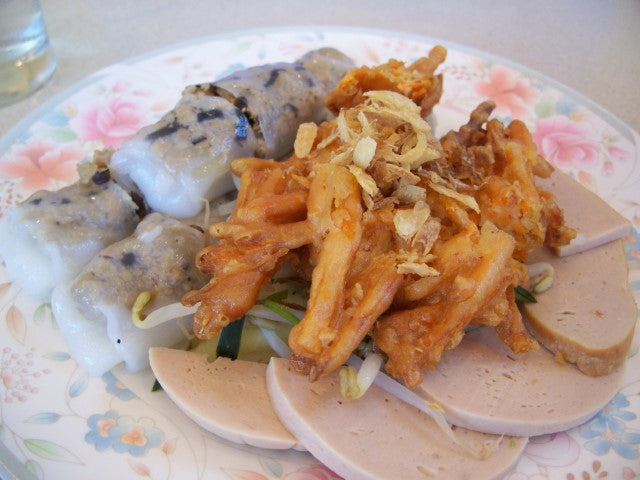CONTENTS
Top 13+ Vietnamese Foods to Taste the Essence of Vietnamese Cuisine
Vietnamese cuisine is one approach to discuss meals, processing methods, concepts of incorporating spices into dishes, and the eating habits of the Vietnamese people. Each cuisine in the regions of North, Central and the Mekong Region of Vietnam is distinct, demonstrating that Vietnamese food is both diverse and distinguished.
Vietnamese dishes are combined in harmony from colour to taste, while being affordable, making the overall dish an irresistible attraction, especially for tourists.
It is hard not to mention the flavour of each region's food. People in the Northern area like bland cuisine, rarely add spices to dishes and dislike sweets in particular. People in the Mekong Delta region, on the other hand, love rich flavour and frequently use a lot of sugar in their recipes. The same is true for Southerners.
Spicy cuisine is a favourite of people in the Central area. Most of their side dishes have a substantial amount of chilli.
In general, the taste is influenced by customs, culture, and natural factors, therefore people in one region will have different tastes than those in other locations. It is a natural beauty, a regional attribute, a habit, and the distinctive culinary culture of each area in Vietnam.
15 Vietnamese Food You Need to Try
If you get the opportunity to visit Vietnam, you must try at least these 15 Vietnamese traditional dishes, otherwise, you will be deemed as if you have never visited Vietnam.
- Pho (Vietnamese Noodle Soup)
- Banh Mi (Vietnamese Sandwich)
- Com Tam (Vietnamese Broken Rice)
- Bun Cha (Vermicelli Noodles with Meatballs)
- Bun Bo Hue (Spicy Vietnamese Beef Noodle Soup)
- Mi Quang (Quang-style Noodle)
- Hu Tieu Nam Vang (Vietnamese Pork and Seafood Noodle Soup)
- Bun Rieu (Vietnamese Crab Noodle Soup)
- Goi Cuon (Vietnamese Spring Rolls)
- Banh Xeo (Crispy Vietnamese Pancakes)
- Cao Lau (Braised Spiced Pork with Cao Lau Noodles)
- Banh Cuon (Vietnamese Rice Rolls)
- Bo La Lot (Grilled Beef Wrapped in Betel Leaf)
- Banh Khot (Vietnamese Savoury Mini Pancakes)
- Bo Kho (Vietnamese Beef Stew).
1. Pho - The World Famous Vietnamese Traditional Noodle
Photo by Kirill Tonkikh on Unsplash
Originating from the North, pho has become a popular dish of Vietnamese people until now. The major components are rich broth, fresh noodles, a few herbs, and chicken or beef. It is reasonably priced and simple to locate on Hanoi's streets. It's good at any time of day, although most people have it for breakfast.
Even though pho is an inexpensive food that can be found on any street, the method for making a bowl of pho is tough. Authentic Pho is best prepared by locals from the North of Vietnam - which is why many people believe it is not as authentic when they try it in the South.
Visitors to Vietnam are urged to travel to Hanoi to savour the standard pho flavour, including famous brands like Pho Bat Dan, Pho Thin, and Pho Ly Quoc Su.
2. Banh Mi (Vietnamese Sandwich)

Banh mi is regarded as one of the most incredible street foods, with a price range that appeals to people from all walks of life. Vietnamese people may find any bread business on the street, making it a convenient, fast food for many.
Most Vietnamese people eat Banh mi for a quick breakfast since it's inexpensive, easy to get, and packed with meat, starch, and veggies.
Cold meats, rolls, herbs, and pâté are all included in Banh Mi. You may, however, put whatever you want in Banh Mi. Many different types of Banh Mi are available, and a complete breakfast costs only one dollar.
3. Com Tam (Vietnamese Broken Rice) - Saigon's Soul Food

Com Tam, like bread, is another standard breakfast option in Vietnam. In Saigon, locals eat Com Tam as much as Hanoi people eat Pho, and it's a relatively simple food to prepare and find.
Ribs, skin, spring rolls, and fried eggs are the most classic and delectable dishes, served with Com Tam. Ribs are the main course, marinated in a variety of seasonings.
Com Tam is constantly on the menu for Saigon locals anytime their stomachs grumble, whether in the morning, lunchtime, afternoon, or late evening. Com Tam is always present and is frequently served as a side dish by many people. Everywhere Saigon residents go, they talk about Com Tam as if it were a recognisable flavour of the city, and if you're unsure what to choose from the options, go with 'Com Tam Suon, Bi, Cha, Trung' - a mixture of all the goodies.
4. Bun Cha (Vermicelli Noodles with Meatballs)

Referring to Hanoi, Vietnam, no one can think of Bun Cha immediately. In 2016, President Barack Obama dined at a bun cha restaurant on Hanoi's Le Van Huu Street.
Bun cha is made up of three essential components: dipping sauce, grilled pork rolls, and noodles. The dipping sauce determines whether a plate of bun cha is tasty. This recipe may be eaten in various ways: combine the sauce with the noodles and serve with meat.
Although it seems an essential meal, tourists are drawn to it because of its flavour. That is also why Bun Cha is frequently mentioned when discussing the significant and long-standing Vietnamese cuisine. Come to 24 Le Van Huu in Ha Noi’s Hai Ba Trung District if you wish to try Bun Cha at the restaurant where Obama had visited.
5. Bun Bo Hue (Spicy Vietnamese Beef Noodle Soup)

Bun Bo Hue is one of Hue's most well-known noodle meals. Different spices have been added to Bun Bo Hue over time. The core, however, still contains Hue's traditional spices. Meat bones and beef are stewed to make the broth. Noodles, beef, pork blood, crab cakes, and broth are all included in a bowl of Bun Bo Hue, but the broth is the essence that gives the meal its flavour.
The scent of a superb Bun Bo Hue bowl, with the old city's flavour, is nothing short of appealing. This is a popular meal in Vietnam's Central and Southern areas, often included while discussing traditional foods.
6. Mi Quang (Quang-style Noodle)
Mi Quang is a beautiful and appealing dish that originated in Quang Nam province. This is one of 12 Vietnamese meals of Asian culinary significance. Mi Quang is created using ordinary noodles and served with various meats, including beef, chicken, egg, and fried shrimp.
On the other hand, its flavour cannot be mistaken with that of any other meal. Mi Quang should be eaten with many fresh vegetables, according to the ancients' experience. You must follow the processing method from the noodles to the processing stage, as well as the spices and supporting tastes, to produce a bowl of Mi Quang that is proper and tasty.
Mi Quang has spread throughout the South and North, becoming a staple of the Central region's cuisine. They are constantly present in people's daily meals as a comfort food and a speciality.
7. Hu Tieu Nam Vang (Vietnamese Pork and Seafood Noodle Soup)

The majority of Vietnamese people consider Hu Tieu to be one of their favourite foods. This famous breakfast meal originated in Cambodia and can be served with or without broth.
If you're eating dry noodles, once you've eaten them, you'll drizzle them with black soy sauce, adding to the bowl's richness. When it comes to broth dishes, the broth should be clear and pleasant so that you feel fulfilled afterwards.
Even though Nam Vang noodle soup is famous across the South, finding a good bowl of noodle soup is difficult. Because they frequently incorporate many different ingredients, large Hu Tieu restaurants frequently cannot retain the traditional Nam Vang noodle bowl.
8. Bun Rieu (Vietnamese Crab Noodle Soup)

Bun Rieu is one of the hundreds of rustic foods popular among Vietnamese people from rural to urban regions because it combines all three characteristics: it is tasty, nutritious, and inexpensive, and it has a rich flavour and an enticing look.
Tofu, pork, snails, crab meat, and herbs are some of Bun Rieu's toppings. Bun Rieu is known for its crab or snail flesh, served in a naturally sweet soup with spices.
Southerners love Bun Rieu, and they frequently eat it in hot weather because they believe eating a lot of veggies would help them cool down their body temperature.
9. Goi Cuon (Vietnamese Spring Rolls)

10. Banh Xeo (Crispy Vietnamese Pancakes)

Banh Xeo has been around for a long time and is a popular meal among the people of the South and the region of Vietnam. Banh Xeo has a unique taste in each location, demonstrating the region's cultural essence.
Banh Xeo is commonly eaten during the rainy season to keep the stomach warm. Each area of Banh Xeo has a distinct flavour; in the Mekong region, the Banh Xeo are often large, whilst in the Central region, the Banh Xeo is smaller. Banh Xeo is commonly rolled in rice paper with herbs and dipped in fish sauce to create a flavour that is both easy to consume and not monotonous. Banh Xeo should be eaten with your hands; chopsticks and forks are unnecessary.
11. Cao Lau (Braised Spiced Pork with Cao Lau Noodles)

avlxyz, CC BY-SA 2.0, via Wikimedia Commons
Cao Lau is a traditional Hoi An and Quang Nam meal. When walking around Hoi An's ancient town, it will not be challenging to discover quaint restaurants with menus labelled ‘Cao Lau’.
Cao Lau is a big noodle dish with a filling of fresh veggies, grilled pork, and notably crispy fried skin, similar to udon noodles but made with mixed noodles. Cao Lau is identical to Mi Quang and served only with a tiny broth.
Cao Lau was once regarded as a high-class meal. When individuals from rural Quang Nam get the opportunity to visit Hoi An, they seek to sample Cao Lau Hoi An and bring it back to their loved ones.
12. Banh Cuon (Vietnamese Rice Rolls)

Mai Truong, CC BY-SA 3.0, via Wikimedia Commons
It is easy to find steamed rice roll stores on Hanoi's streets since they are famous among Vietnamese and draw international visitors due to their delectable taste. The processing procedure varies to suit local tastes in more remote areas, such as the Central or Southern.
In general, making steamed rice rolls is a relatively straightforward process. The steamed rice roll shell is constructed of rice flour, and the pork and mushroom mixture is served with fish sauce and pork buns.
Banh Cuon is frequently served as a morning meal following the traditional eating customs. It is more than a meal; it symbolises Vietnamese cuisine's complexity and subtle tastes.
13. Bo La Lot (Grilled Beef Wrapped in Betel Leaf)

Bo La Lot is a popular street food in the South due to its unique flavour and low cost. Raw veggies, peanuts, and a dipping sauce accompany this meal. The characteristic taste comes from the meat rolled in guise leaves, which are aromatic and moderately spicy. When you bite into a piece of tender and sweet beef, it melts on your tongue, even though it has been grilled.
However, because this meal is served with a Central region fermented sauce, many international visitors find it difficult to eat because of the unusual flavour. Still, once you get used to it, you will find it quite aromatic and unique.
14. Banh Khot (Vietnamese Savoury Mini Pancakes)

manda_wong, CC BY 2.0, via Wikimedia Commons
Banh Khot is a well-known and well-liked cuisine in the South. Making this is simple, but it does require sophistication and skill. In addition, there is a specific ancestral recipe for creating the dough. As a result, while you can have this meal elsewhere in Vietnam, no location is as brazen as Vung Tau.
Each Banh Khot is large enough to be cut in half or eaten whole. Raw vegetables, such as mustard greens, lettuce, perilla, and shredded papaya, are served with Mini Shrimp Pancakes. Mini Shrimp Pancakes dipping sauce has a tangy, sweet, and delectable flavour. When serving, guests can add a pinch of spicy chilli to the dipping sauce to amp up the flavour.
15. Bo Kho (Vietnamese Beef Stew)

Nam Ngo, CC BY 2.0, via Wikimedia Commons
Bo Kho has long been regarded as a traditional Saigon cuisine, dating back to the French colonial period. Everyone enjoys it, whether it is from the past or the current. We are still ‘attracted’ by this intense flavour as we travel about the city, from upscale restaurants to roadside cafes.
The mild and ethereal braised beef dish is created by the sweet and fatty taste of the sauce combined with meat, basil, and cilantro. Beef is cooked for 5-8 hours with spices so that the softness and juiciness of the flesh may be felt when eating. Because this meal is served with noodles and bread, it may be used to make various dishes.
Regardless of the dish, the 15 Vietnamese foods you need to try listed above have contributed to Vietnamese cuisine's reputation across the world. When visiting this Southeast Asian country, try all the various traditional meals with distinct flavours and characteristics.
Vy Nguyen
















Leave a comment